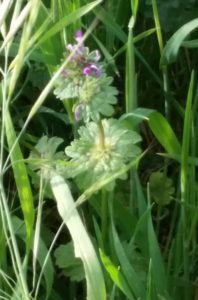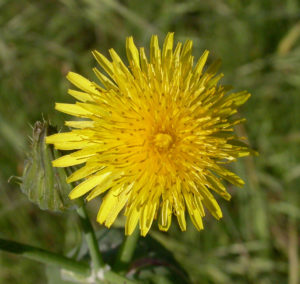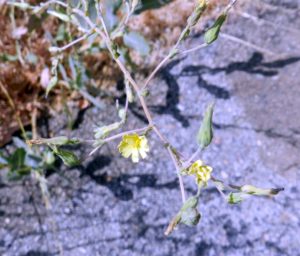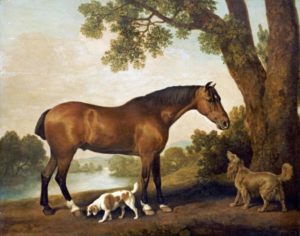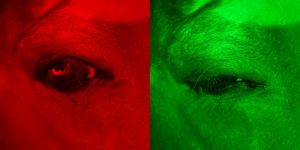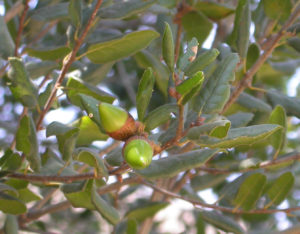Buddy, the over-the-hill horse, has had chronic lameness for over a year (more information in an upcoming post), and I’ve ridden him on trail very little, and in competitive trail rides not at all, which has been deeply disappointing.
But I was able to ride in the NATRC competition in Peñasquitos Canyon (north of San Diego) last October on a borrowed horse named Milagro. He is a Spanish mustang belonging to the author Audrey Pavia; she has ridden him in a number of competitive trail rides. Audrey has a younger Spanish mustang, Rio, that she is bringing along as a trail horse, and she wanted to start him out in the company of his paddock pal. I was pleased and honored that she asked me to ride Milagro.
Milagro and Buddy have similar builds, in that they are both short and stocky, with short massive necks set high. Buddy clearly has some mustang heritage, but his draft heritage makes him more massive than Milagro. Buddy’s feet are larger, but Milagro’s are narrow and tougher. When Buddy gets concerned on the trail, he usually goes faster. When Milagro gets concerned, he often stops.
Milagro is an experienced trail horse, and I am an experienced trail rider, and on the rocky up-and-down single-track trails of our conditioning rides he was a champ—less impulsion than Buddy, but more sure-footed. But on street trails, he slowed to a crawl, even when he was headed back to the barn (at one point I almost jumped off to lead him, thinking my walk would be faster than his). I agree with Audrey that he finds little of interest on the street trails except plants to munch on, and those require slowing down anyway. I was concerned by his speed, because NATRC rides have a set time that requires a pace of 3–4 miles per hour (for the Novice and Competitive Pleasure classes), and neither he nor Rio were even coming close at the walk.
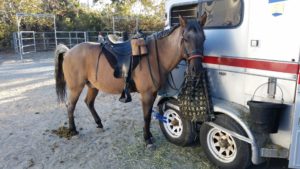
But it turns out Milagro is also an experienced dressage horse. I took him to a public arena and reminded him that he knows the working walk and the working trot, and then took him back on a street trail and reminded him that they are the same there as on the sand.
Ride day dawned chilly, but it heated up fast, with highs in the upper 90s. Audrey and I were both riding Novice, I because I’m a novice rider, and she because Rio is a novice horse. Fortunately she was in the lightweight division and I was in the heavyweight, so we weren’t competing against each other. The Novice course was just over 18 miles. Before lunch, it went upstream in the canyon (east), to a hill which was the first judged obstacle, and at the top of which would be a check of the horses’ pulse, respiration, hydration, and soundness (P&R). There were a couple of water crossings, some woodland, some chaparral and dry grass, and a fair number of bicyclists and dogs. Toward the end, the trail passed below a housing tract—Peñasquitos Canyon is an oasis of old California cutting through plateaus covered by suburbia.
Less than a mile from the turn-around hill, a couple of riders came back our way to tell us the trail was blocked by fencing. It turns out a water main had burst since the last time the ride managers walked the trail, washing it out, the gully was fenced off, and there was no way to proceed. We informed the ride managers by cell phone and they told us to meet them under a highway bridge where the trail ran along the creek.
Shade and water are a special delight on a hot ride. Milagro drank, and then decided to check out the edible vegetation along the shore. He likes to take every opportunity to eat. Many horse people say you should never let a horse eat along the trail, but they aren’t distance riders. The goal is to get the horse to eat when you allow it, and to allow it often enough that it’s not a battle. It has been a training challenge for both Buddy and Milagro, Buddy because he was initially sure it was never okay to eat, and Milagro because he initially didn’t see the point in not eating.
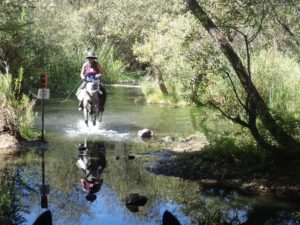
Lunch was back at camp, and the riders and horses could both eat and drink freely. After lunch, the course went downstream, to the west. It was laid out as much as possible to stick to single tracks, to avoid bicycle traffic. About a third of it was through riparian woodland, with several water crossings (one was a judged obstacle). The rest was through scrub and grassland.
As we progressed, Rio showed signs of lameness, especially at the trot, so that we weren’t able to make up time from the slow walk. Because of the lost hill climb plus P&R in the morning, we were asked to trot the last quarter mile before the afternoon P&R. The vet checked Rio, and he and Audrey decided to pull him from the competition (he was trailered back to camp). I continued with Milagro.
This was a challenge for both horses. Either is fine with riding out alone, but they were not happy about being separated, because that wasn’t part of the plan. As we rode away, Rio would whinny, and Milagro would stop and whinny back, so loud that his sides would shake and I could feel the bass notes up my spine. I would reassure him, and we’d ride on until the next whinny. The interchanges stopped after Rio was trailered away.
Milagro decided he needed to be back at camp. I had told him that Rio would be there when we got back—I don’t know whether he was listening to me or figured it out on his own, but he was ready to go. I didn’t want him to trot through the woodland, because there were low-hanging branches and areas of uneven footing, so I rated him back and a little bit of magic happened.
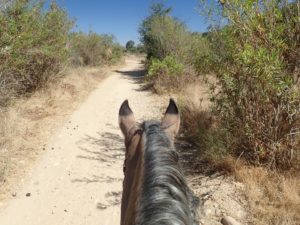
Many mustangs have an ambling gait between the walk and trot, technically a stepping pace, that is sometimes called the “Indian shuffle” because it was observed in the ponies of First Nations riders. It’s a genetic legacy of the ambling horses of Iberia that were the mainstay of the conquistadores. Buddy has it, and once I figured out what it was and learned to ask for it, I used it a lot on trail—it’s about three and a half to four miles an hour, perfect for the Novice NATRC rides. Audrey had told me that both Milagro and Rio had originally shown this faster gait, but that it had evidently been trained out of them. But when I rated Milagro back from a trot, he dropped into an amble, and I broke into a big smile. Milagro ambles at about three miles an hour, but it’s still faster than his walk. He was satisfied with his progress, and we ambled back into camp.
Once we had our time, I rode him straight over to where Rio was tied to the trailer. They snuffed noses, and if I was understanding them correctly, Rio said “Where have you been?” and Milagro said “I’m glad to be back. You got any hay?”
As best Audrey and I can figure, Rio had a small pebble in his hoof boot pressing against a heel bulb, because when she removed the boots in camp, he was basically sound. Ride and learn.
Each horse you ride teaches you something new, and that makes you a better rider for every horse you ride
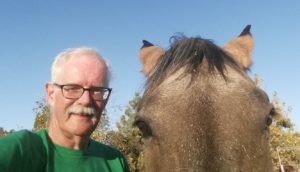
Even before I really understood why, I knew it was important to ride multiple horses. Horses are as different as people, but until you’ve worked with a lot of horses, that statement is just words. There’s nothing to compare to the deep bond that can form over years between a rider and a horse, but each horse you ride teaches you something new, and that makes you a better rider for every horse you ride. When you approach each new horse with the attitude “What can this horse teach me,” you can only improve as a rider, and the horses whose lives you touch will be better for it as well.
I’m a better rider for having ridden Milagro, and he says he was okay with it, too.

